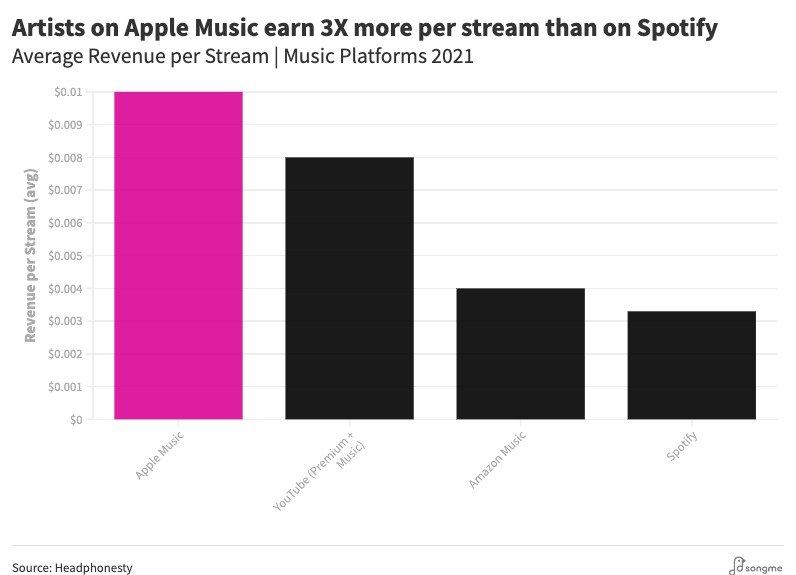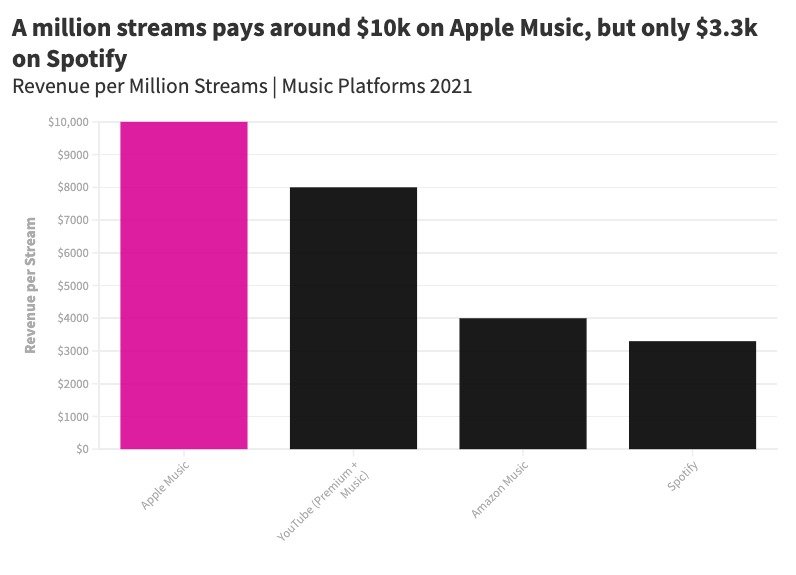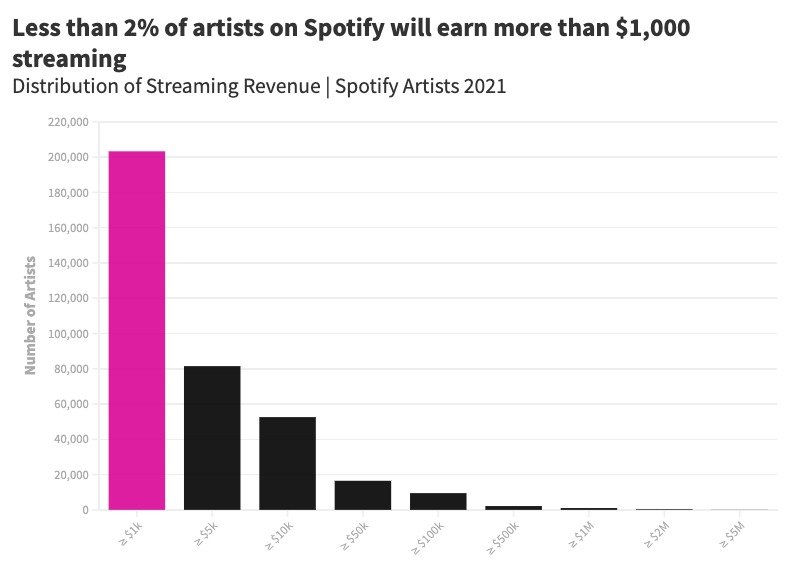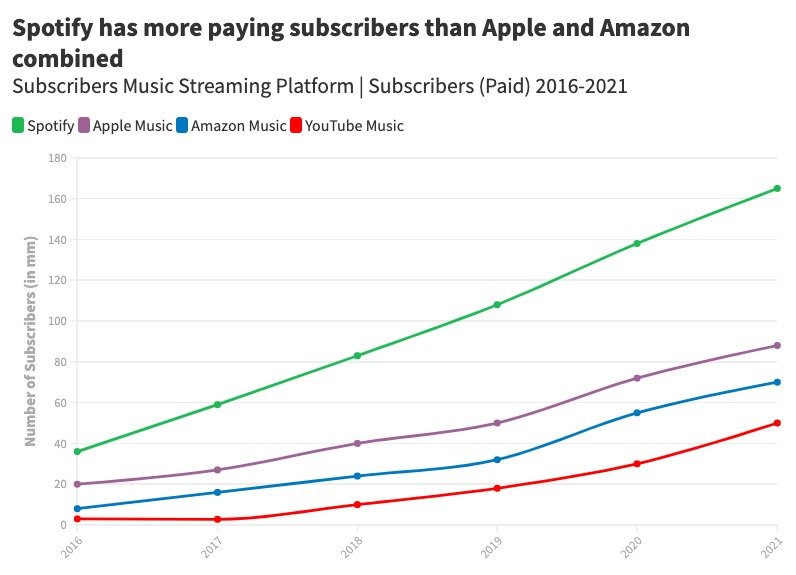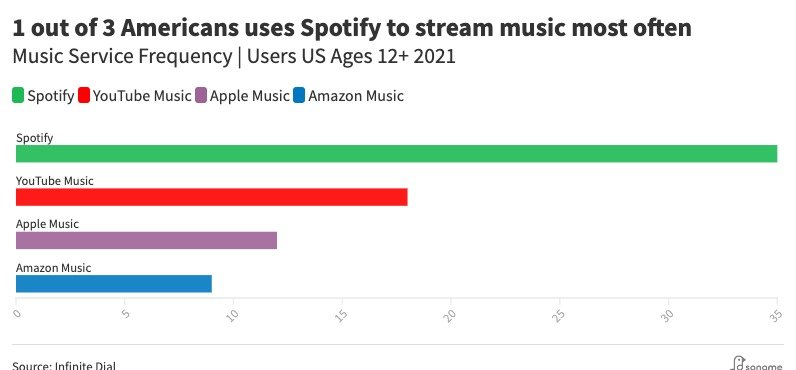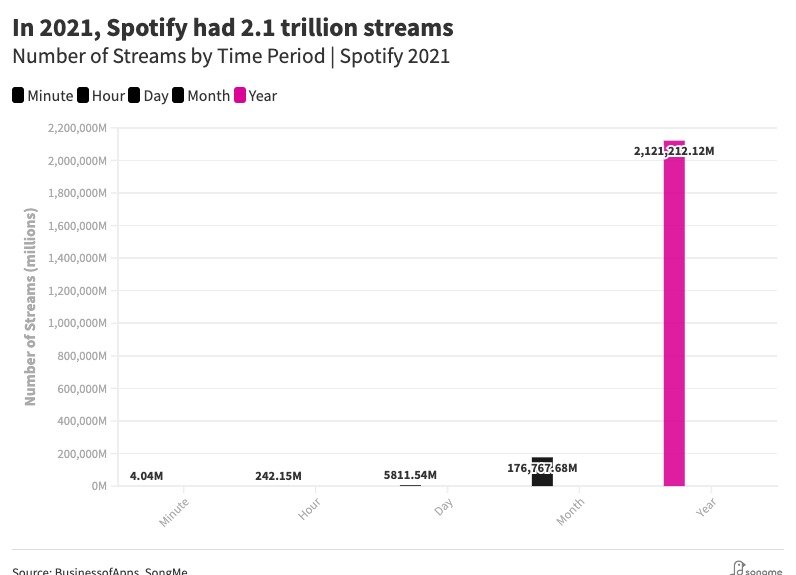Does Apple, YouTube, Amazon, or Spotify Pay Artists More?
As a musician, I know that streaming services are an important part of promoting my music, but not necessarily the most profitable part of my business. I decided to research which music streaming service is the best at building income for musicians.
Apple Music pays musicians the most per stream, averaging $.01 per stream. Although Apple Music has half the subscribers of Spotify, on average, it pays nearly three times the amount per stream compared to Spotify.
Streaming is essential to building a music career for today's artists, but it's not all rainbows and butterflies, especially if the best paying platform averages $.01 per stream. To pick the best platform and get the most out of streaming, there are some other factors outside of revenue per stream that you need keep an eye on.
In this article, I'll help you figure out which platforms to prioritize. I'll show you what each major streaming service pays per stream, what other independent artists are currently making, and where your audiences stream music.
What Streaming Service Pays the Most per Stream?
The average artist gets $.01 per stream on Apple Music, which is significantly higher than the other popular platforms in the United States. If you were to get one million streams on Apple Music, the platform would pay out around $10k.
For comparison, on average, YouTube pays $.008 per stream, Amazon Music pays $.004 per stream, and Spotify pays $.0033 per stream. Yes, you read that correctly, Spotify pays out $.0033 per stream.
I don't know about you, but none of those financial figures look impressive, it's even hard to understand what the highest paying service (Apple Music) means monetarily - sure, I know that $.01 is a penny, but how many streams do I need to make it worth my while?
A penny may seem low, obviously because it is, but it's a penny per stream - many platforms, including Spotify, consider a stream to be when someone listens for at least 30 seconds.
So, let's imagine that one of your tracks took off and got a million streams over a year. What would that mean financially?
There's a lot of sweat, tears, and luck involved in getting one million streams in a year. And yet, the best-case scenario for streaming revenue is $10k, and the worst-case scenario is $3.3k.
Here's the sand in your eyes while you're laying on the ground.
If you work with a distributor, and your arrangement involves placing your music on Spotify, let's say CD Baby or Tunecore, you can expect your cut to decrease even more. If you go that route, hopefully, those distributors will be able to increase your stream count so you ultimately bring in more income.
With this revenue per stream information alone, it seems that Spotify has put us artists in an interesting position.
Spotify knows that they hold one of the most valuable audiences, which happens to be the largest share of music-specific paid subscribers by a significant margin. So they naturally pay the worst for a stream - because, why not?
Spotify is banking on artists choosing quality exposure to a valuable audience over artists choosing to focus on platforms that pay the most revenue per stream. It's the independent musician's dilemma of the day.
Spotify's leverage and forced predicament is the biggest reason why independent artists rarely make a living wage through streaming on Spotify.
Which brings us to our next installment - what can you expect to earn by streaming on Spotify?
How Much Do Artists Earn Streaming on Spotify?
Around 98% of Spotify artists made less than $1,000 a year on streaming in 2021. According to Spotify's Loud & Clear, 203,000 out of the over 11 million artists on Spotify (new figures from Spotify Q4 earnings call) earned over $1,000 in 2021.
The actual figure is that 1.85% of artists earn more than $1k a year streaming (I was just rounding up.) Yikes, that figure hurts.
If you need some added context, don't sweat, I got you.
Musicians Have a Slightly Better Chance of Earning $1K Than Going NFL
In 2020, there were 73,000 football players in the NCAA (Division I to Division III. Of those players, 16,380 were eligible to go pro. Of those eligible to go to a professional league (think age requirements here,) 254 successfully made the transition.
So my headline there is a little misleading, but for the mathematicians out there, that's a 1.6% conversion rate of going from college football player to pro.
So, as a musician, you have slightly better odds of earning over $1,000 streaming on Spotify in a year, than a college football player turning pro.
Hooray! What a relief.
Sorry to kick you while you're down, but the truly depressing part about this stat is that you would need over 300,000 (~303k total) streams just to make $1,000 on Spotify.
Over 200k Spotify Artists Had a Million Streams in 2021
And yet over 200,000 people successfully did just that in 2021. Well done you all. In fact, there were quite a few who even earned well above that number.
Ok, so Spotify doesn't pay the best, you get my point. Then surely it's the most popular, right?
What is the Most Popular Music Streaming Service?
Globally, YouTube Music is the most widely used music streaming service by a large margin, with over 2 billion users. The second most popular music streaming service is Tencent which is most popular in China and boasts 800 million users.
The third most popular music streaming service is Spotify - between its paid subscribers and freemium users, there are 381 million people on the platform.
While all the data above includes a mix of paid and freemium subscribers, there's something to be said for paid subscribers and their motivations.
This breed of listener is typically going to be an audience that values a pure music experience and is willing to throw down their hard-earned money for an ad-free experience.
I'd venture this is an audience more likely to support you monetarily compared to a freemium user. In that case, let's have a closer look at paying subscribers and which music platforms have the most.
What Music Streaming Service has the Most Paid Subscribers?
Spotify has the most paid subscribers, reporting 165 million in 2021. Due in large part to being first-to-market, Spotify has a dominant market share for paid subscribers.
The second most popular music subscription service is Apple Music, which reported 88 million subscribers in 2021.
Rounding out the third and fourth most popular music subscriptions are Amazon Music and YouTube Music, reporting 70 million and 50 million subscribers in 2021 respectively.
I find it fascinating that the global juggernaut of YouTube, has a lower percentage of paid subscribers than Spotify, Apple Music, and Amazon music.
Maybe it's due to the way people use these platforms- with YouTube often used as a discovering platform while Spotify focuses more on focused listening habits
For me, the main takeaway is that each platform has something valuable to offer. With YouTube (and arguably Amazon Music) you get a baked-in audience that will give you some solid exposure.
With both Apple Music and Spotify, you'll find a more premium listener - while Apple Music pays the best, Spotify has that quality listener at a much larger scale through their subscribed listeners.
Of course, it's not always as simple as picking YouTube for popularity, and Spotify for quality - what about the fans? If you can't be on every platform and manage the experience well, you should think like your fans and figure out which platform they use the most to guide your decisions.
What is the Most Popular Music Platform in the US by Age?
YouTube is the most popular music platform in the US, with around 44% of US adults using it across all age groups. Even with the 18-34-year-old age group, YouTube has higher usage than Spotify.
The platform with the least usage is Amazon Music, but it's important to remember that this still represents millions of people.
Also, if you're trying to add up the numbers in the chart above to make sure they equal 100%, I'll save you time. They don't.
That's because most people listen to multiple streaming services, and this can vary based on location or even who they are with - like driving in your car solo vs. driving with your kids in the back seat.
YouTube (and Amazon Music) Have Built-in Reach
I was surprised that YouTube was still the most popular for a younger demographic. I fully expected to discover a new platform I had never heard of while researching this part. But this does make sense if you sit and think about it for a minute.
YouTube benefits from the ability to listen to music on two apps - YouTube Music and the regular YouTube app, which focuses more on music videos.
There are tons of ways to watch videos today, I mean music and Tik Tok are inseparable. But for a full video viewing from your favorite artist or a live session, YouTube is most likely going to be one of the first stops on the streaming tour.
YouTube is the Third Largest Search Engine in the World
Purely looking at the numbers too, this YouTube data shouldn't be all that surprising given YouTube is the third most popular search engine, just behind Google Images.
For those keeping track, that means Alphabet, which owns Google, Google Images, and YouTube has the three most popular search engines.
The Value of Understanding Your Audience
If you're trying to decide where to focus your efforts as an artist or band, these numbers can help give some guidance. But if you only look at absolute numbers and percentages, you are going to miss out.
For instance, if you made your decision to focus on a platform solely based on the age breakdown by platform, that could be a misstep.
Maybe that data is suggesting that the respondent uses YouTube every morning while they comb their hair, but every other day they listen to Amazon Music for their daily commute - and it's an hour drive each way.
In that case, I would rather have the Amazon Music platform.
Hopefully, you see what I'm getting at - there are a lot of variables that go into play here. An easy one related to the "Most Popular Music Platforms by Age" chart, is to look at the breakdown of which streaming services are used the most often.
That could give a better view of where a listener is actually spending their time.
What Music Streaming Platforms are Used Most Often?
Spotify is the most frequently used music streaming service, with nearly 35% of American adults saying they listen to music on the platform most often. YouTube is the next most used platform, with 18% of Americans reporting they use YouTube most often.
Well here I go again (on my own... going down the only road I've ever known...) One minute I'm in the YouTube camp, the next I'm on team Spotify. Which is entirely my point.
How Do You Prioritize a Streaming Platform to Focus on?
If you're trying to get maximum exposure to your music, YouTube (including YouTube Music) seems like it should be a priority. You know you're music better than anyone though and should start with your fans first and foremost.
As it relates to your audience - you'll want to get close to their behaviors and where they hang out online. You may want to be agnostic of the numbers you just read and go into this with fresh eyes.
Dig around on all four platforms and see which platform, imagine your typical listener, and find where they congregate on each platform.
Aside from YouTube just being a numbers game, where does your typical fan age range land? What about their interests and geographies? That should guide you on another way to prioritize your platforms to add into the mix for exposing your music to the right audience.
Spotify is certainly an important platform from quality of listener perspective, but also valuable when you look at the volume (yes that's a pun) of listeners. AKA, Spotify has quality AND quantity.
And while Spotify's nearly 400 million users look puny compared to YouTube's 2 billion, when you take into account audience behaviors, like frequency of listens, well you start to view Spotify in a different light. Well beyond monetary gain of streaming revenue.
How Many Streams Does Spotify Have in a Year?
According to Spotify, in 2021 the company paid out $7 Billion for streaming rights to artist music. With the average stream paying $.0033, Spotify roughly had 2.1 trillion streams in the year.
Trillion. With a "T" - and I'm going to capitalize/bold/underline/italicize that for emphasis.
Trillion is so huge, that you can't even see the 4 million streams in a minute or the 242 million streams in an hour. All those numbers are hard to comprehend really - when you introduce 9 and 12 zeroes to numbers, the scale quickly becomes incomprehensible.
So let's start "small" and build up the context.
How Many Daily Streams Are Needed for a Million Streams a Year?
Let's say you wanted to get a million streams a year - on average you would need 2,780 per day to hit your goal. That's a lot, but possible. Especially since 238,000 songs on Spotify were streamed over a million times in 2021.
How's your brain doing? Want to look at a few more numbers? Perfect.
How many daily streams would you need to reach a billion or trillion streams a year?
You would need 2.8 million streams a day to reach a billion streams in a year.
And this is insane but if you wanted to reach a trillion streams in a year, you would need to get 2.7 billion streams a day for 365 days.
As crazy as the trillion streams figure looks and sounds, Spotify did this in 2021. Actually they did more than twice that a day - Spotify is getting more than 5.7 billion streams a day.
In case you're a visual learner like I am, let's use a different example to explain this - where every stream is equivalent to 1 second (I know it's off-topic, but I'm a sucker for this stuff and visual context.)
So if Spotify had 2.1 trillion streams in 2021, and each stream was worth one second, how far back in history would we be able to go?
Damn. That's pretty far back. We hit the times of the neanderthal, with wooly mammoths running around, and all that jazz.
As you can see, the total number of users on a platform isn't everything, there are many factors at play - audience type via demographics like age, or behaviors like frequency of streams are just as important as the total number of listeners.
And in this case with Spotify, it's pretty clear that they do have a valuable audience that listens to a ton of music.
How Every Musician Should Approach Streaming Services
Bringing this back from the past, the overarching takeaway is that if you are in the music business, your marketing and distribution of music needs to be multi-platform.
Figure out what your goals are and define the role of each streaming channel.
A good place to start is to figure out your channel for the most exposure potential, your channel for where your audience currently lives, and the channel that gives you the highest return per streaming.
Yes, that's three channels. It could be one channel does all three of these, or it could mean your streaming mix needs to involve three separate platforms.
Regardless, doing this exercise will help you focus your energies and establish where you need to invest time and energy.
I know this article can be a bit heady with the charts and data, but your music is your product. And your show is your experience. Using data and looking at your fans' behavior is an important step in making sure you maximize your earnings potential is crucial to being in the music business.
I think the biggest oversight about streaming is that artists lose sight of the value in reaching a new audience, and put too much energy on revenue from streaming.
If you were able to get a million streams on Spotify because your audience is there, but you only earned $3.3k for that work would you take it?
I know I would. That exposure could be monetized elsewhere - it could be on merch on my site, live show attendance increasing, more followers on Instagram leading to influencer deals, or one of the many other ways to earn more money as a performing musician.
So there you have it - more than you ever cared to know about music streaming revenue.
Streaming platforms shouldn't be looked at in isolation. Just like all the other ways you can earn more money as a musician, there's no single way to measure value. And that includes only looking at revenue.


